 You may find this difficult to believe, but sometimes I run out of thoughts… and then I run out of words… and then I find myself half way through an article, staring at the flat screen with both hands poised on the keyboard, thinking, “Wow! This is crap”. I had a ton of project material deposited all over the shop, on my desk and on the floor. Stuff that would normally keep me locked in the shop twelve or fourteen hours a day, or filled with positive anticipation and starting work at 5AM. But yesterday I was just burnt to a crisp, capable of producing only vacuous thought bubbles. So I went back over to the house and watered the lawn, as though I actually believed the grass seed I planted three months ago was going to be… reanimated. Sure, just like the sea monkeys I bought is ’62.
I was trying to think “guns”, but all that came out was, “I need to paint the house trim and porch”, ” I need to patch and reseal the driveway”, “I have to get that walkway put down before fall”, “I need to get a pool up for the grandkids”. My head started to spin like a Mel Brook’s vertigo attack in “High Anxiety”, until I was forced to medicate – Fried turkey with Swiss, lettuce, tomato and mustard on thick crusted French bread I made myself… and a glass of ice tea.
I wandered back over to the shop and began going through safes and locked cabinets, hoping something would, metaphorically speaking, jump out at me. Finally something did, the subject of “Remington’s VS SF II .220 Swift Part I“, an article that concluded with “I will be back soon to report how the bullets flew out of the barrel rather than my calculator”. Wow! Liar, Liar Pants on Fire. But I have an excuse… No, actually, I don’t have an excuse. I just didn’t get it done, however, I now had a chance to make amends.
Missing this Part II was really unfortunate as the Swift was on my half century old list of rifles I have to own one day. I love the rifle and the cartridge. It is in the words of Eddie Floyd, “Like Lightning. Like Thunder…” It is the only factory built American Hot Rod to retain a seventy five year old speed record. Current factory guns keep handloaders inline with the cartridge’s original intent – long range varmint hunting, by employing a relatively lazy 14″ twist. This prevents excessive light bullet rotational speed, but limits best accuracy to bullet weights between 40 and 60 grains.
Most people think the Swift is a circa 1935 derivative cartridge, made by necking down the 6mm Lee Navy to 0.224″. However, as real history can be incredibly boring, I’ll take a page from the Democratic Party’s “Create Your Own Realities'” playbook and attribute the 220 Swift to… Jonathan Swift and its first appearance in Gulliver’s Travelsas one of Gulliver’s cultural encounters; Lilliputians, Brobdingnagians, Houyhnhnms, Yahoos, and the Swifties.
OK. I think I am now ready to concentrate… A little thinking
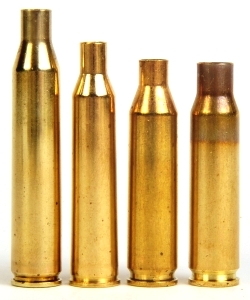 For the sake of cartridge comparison and capacity, L-R, .25-06 Remington (65.8 grains), .220 Swift (47.0 grains), .243 Winchester (54.0 grains), .308 Winchester (56.0 grains) . The Swift, because of its 2.680″ overall length, will easily fit a short action designed for 2.810″ .308 Winchester length cartridge. While the Swift’s case is 0.190″ longer than the .308 Winchester, the small 0.224″ bullet is considerably shorter, bringing the overall cartridge length below that of the .308 Winchester.
I am not sure why the .220 Swift has a reputation for being a barrel eater; an absence of appropriate powder, misapplication of the cartridge, period writers with unsupported theories, and substandard barrel steel in early guns – probably in that order.There is a very exacting formula that places the potential for barrel erosion and wear into relative context… the Basic Universal Laminar Linear calculation and, yes, I did just make this up but it takes into consideration ratio of bore to case capacity as well as the force that initially moves everything across the barrel throat and onto the leade where the most severe erosion might occur. After those points, ever increasing containment volumes, varied gas production and peak pressure dissipation become factors and the whole issue begins to give me a headache.
My point is that the 220 Swift is no more overbore than many popular cartridges that are thought to be more mainstream. It is easy to reload and components are inexpensive and it is reasonable to expect 150 rounds from a pound of powder.
OK, line up, tallest first,,,
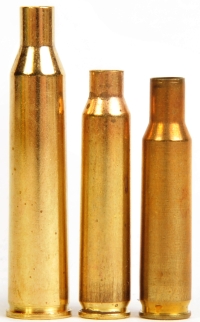 In the 0.224″ scheme of things, there are probably four cartridges that see popular use; L-R 220 Swift, .223 Remington and .222 Remington, with the .223 Remington the run away dominant cartridge. The fourth is the 22-250 Remington that I unfortunately don’t handload and had no brass to put on display. The .223 Remington is not leading so much for its performance in accuracy or power, or as an effective varmint round, but rather as a result of the popularity of all of those AR-15 type rifles. From all of the NSSF marketing data I have seen, the .22-250 Remington is the big cheese long distance varmint shooter. In the 0.224″ scheme of things, there are probably four cartridges that see popular use; L-R 220 Swift, .223 Remington and .222 Remington, with the .223 Remington the run away dominant cartridge. The fourth is the 22-250 Remington that I unfortunately don’t handload and had no brass to put on display. The .223 Remington is not leading so much for its performance in accuracy or power, or as an effective varmint round, but rather as a result of the popularity of all of those AR-15 type rifles. From all of the NSSF marketing data I have seen, the .22-250 Remington is the big cheese long distance varmint shooter.
If there is one great shame the 220 Swift must bear, it is inefficient use of propellant. Sure, just like at the forefront of a Ferrari owner’s thinking is Al Gore, going windmill green and the price of a gallon of gas. Makes more sense than an opera named Enger…
I always thought that Norma was the family name of the folks who founded the company. Actually, the company was started by the Enger brothers in Norway, then expanded into Sweden. One of the brothers enjoyed Bellini’s opera “Norma” and that is where the company got its name. Today, Norma is owned by Ruag Ammotec AG of Sweden. I don’t know if they like opera. I am not particularly a Bellini fan other than of Momma Bellini’s in Clifton, N.J.. I tend to save Norma brass for special occasions, like when I find I have way too much money in my pocket and I want to get rid of it as quickly as possible. The brass is sort of chamfered and deburred, but still in need of clean up. The primer flash hole is drilled rather than punched for dimensional stability and the cartridge brass alloy seems to be annealed so it is slightly softer than other brands at the neck and shoulders. It is produced mid length dimensional spec. Norma brass does size easily and it does last for many cycles of reloading, even with hyper pressure cartridges. Still, $100 per hundred compared to $49 for Remington and Winchester brass? OK, which two don’t belong?
A good example of why more than weight should be considered when selecting bullets. The de facto formula for calculating twist rates is Greenhill, where bullet length is the dominant factor, not weight. There are a number of alternative formulas that take into account other factors, but running them all side my side doesn’t seem to result in much of a variance. Small diameter bullets are more difficult to stabilize as they have less gyroscopic inertia. Heavy small bore bullets have a long nose, which acts as an extended lever under aerodynamic pressure to cause them to yaw and eventually tumble to the tendency is to push them faster. Unfortunately, too high of a rotational speed tends to exaggerate the effects of inconsistencies in bullet material or manufacturing process which also result in a loss of stability. In the case of the 0.224″ bullet at high velocity, there is so much difference in bullet length with each small increment of weight that each increment of twist rate can accommodate only a narrow weight range. This sensitivity to twist rate doesn’t only apply to the Swift as the ,22-250 Remington, and even the .222 Remington, have the same type of dynamics. The 223 Remington, for the most part, runs with a tighter twist rate in the 12″ range for sporting rifles because of it’s lower velocity. Frequently, a 9″ twist rate is applied to AR-15 type products because heavy bullet weights are the norm within this gun’s common applications where bullet mass, retained energy and controlled expansion are preferred to a varmint rifle’s spectacular, but somewhat superficial bullet impact. If I were to build a Swift for Antelope hunting, I would move up to incredibly wind slippery 80-90 grain bullets with an MV in the 3200-3300 fps range and spin them with a 7″ twist… a realize the exercise was a waste of a really terrific varmint rifle. Loading notes…
Cases as received were 2.200″ +/- 0.002″. After full length sizing they were all trimmed to a uniform 2.195″, the trim too length and inside/outside chamfered. I typically use an RCBS trimmer, however, I didn’t have a #11 shell holder so trimming was done with a Hornady lathe type trimmer. Nice piece of equipment and it uses a press shell holder. New Dimension Hornady dies were used for this project. The expander in the full length sizing die measured 0.223″ which, after brass forming spring back measured 0.221 when checked with a pin gauge. I felt this would provide enough neck tension, however, I may revisit this and polish the expander down another 0.001″. Bullet – case concentricity was excellent right out of the dies. I used a Hornady Concentricity Tool to check each assembled cartridge and run-out was within 0.001″. Above is the first step in load development; minimum loads for each bullet configuration before stepping up and expanding sampling. Twenty four rounds become seventy two rounds when bracketing minimum, mid and maximum loads, then three hundred sixty rounds, five samples of each, for pressure sampling and measuring velocity consistency. Shooting Impressions The Remington rifle performed well. The chamber was about mid spec, based upon measurements taken from fired brass. The action was smooth, cycling was reliable and there was no problem with COL restrictions in magazine or chamber for any of the handloads identified. There was no bolt sticking, no bolt face extruded case heads, although the appearance of spent primers would suggest the level of load would be… frisky? … enthusiastic? They are not minimum loads. Measuring headspace on cases before and after firing showed increases between 0.002″ and 0.006″ with degree of change not tracking to a particular powder type or bullet weight. The Swift’s recoil in this near ten pound scope rifle combination was negligible. Report is brief, a little sharp, but not like the rolling thunder sound of large magnums. It is an easy combination to shoot and the Remington X-Mark Pro Adjustable adjustable trigger contributed to this more than a little. Performance was good with lighter loads as noted, so I’ve reluctantly concluded that full tilt performance is not necessary all of the time. The 220 Swift is a little like a fighter jet; just because it has afterburners doesn’t mean its always necessary to stay on the throttle. The barrel can generate some heat. In fact, since I was shooting around lunch time, after every ten shots or so we’d grill a dog on the barrel flutes. Really. Well, maybe not really, but ten shots did get the barrel hot enough for me to break out the cool down box to shorten wait time. Something more quantifiable…
At 100 yards, there wasn’t a whole lot separating bullet brands and weights when it came to group size. The target at the left has a 3/4″ bullseye, the group size is 0.4″. It was shot with Remington 45 grain bullets and Re15 powder as the load appears on the table above. Another good shooting bullet was the Combined Technologies 50 grain bullet that shot numerous sub 1/2″ groups, favoring the H414 load. Remington 55 grain and Sierra 40 grain both were under 0.7, the best coming with BL-C2 powder for the 40 grain and H414 for the 55 grain loads.
Remington’s VS SF II .220 Swift and Elite 6500 Bushnell scope make for an excellent combination. It’s always nice to work on data collection and accuracy without getting beat profusely about the head and ears with a heavy recoiling rifle. This is a well mannered combination and one that can be shot at long ranges with confidence. Remington’s VS SF II .220 Swift Part I |
|||||||||||||||||||||||||||||||||||||||||||||||||||||||||||||||||||||||||||||||||||||||||||||||||||||||||||||||||||||||||||||||||||||||||||||||||||||||||||||||||||||||||||||||||||||||||||||||||||||||||||||||||||||||||||||||||||||||||||||||||||||||||||||||||||||||||||||||||||||||||||||||||||||||||||||||||||||||||||||||||||||||||||||||||
Comments appearing below are posted by individuals in a free exchange, not associated with Real Guns. Therefore RGI Media takes no responsibility for information appearing in the comments section. Reader judgement is essential.

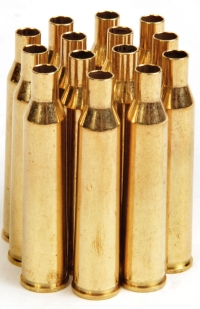
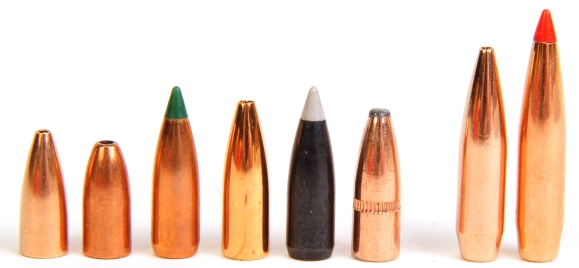
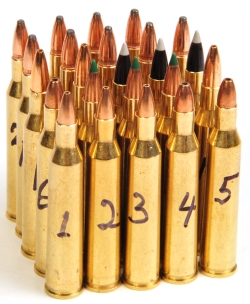


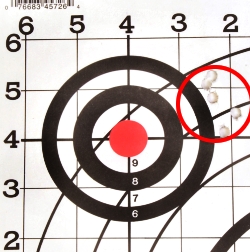 At about half an inch, the Berger 50 grain bullets did well at 100 yards, however, they did great at 200 yards, at least within my shooting capability and with a little gusting wind. The five shot group pictured right measured 1.2″. I like to shoot at longer ranges. I just don’t have the opportunity as often as I’d like. My guess is that the two lower shots were more me squirming at the bench that the rifle.
At about half an inch, the Berger 50 grain bullets did well at 100 yards, however, they did great at 200 yards, at least within my shooting capability and with a little gusting wind. The five shot group pictured right measured 1.2″. I like to shoot at longer ranges. I just don’t have the opportunity as often as I’d like. My guess is that the two lower shots were more me squirming at the bench that the rifle.
Email Notification